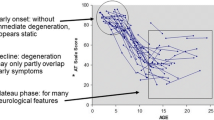Abstract
Ataxia–telangiectasia (A-T) is an autosomal recessive inherited disease characterized by progressive childhood-onset cerebellar ataxia, oculomotor apraxia, choreoathetosis and telangiectasias of the conjunctivae. Further symptoms may be immunodeficiency and frequent infections, and an increased risk of malignancy. As well as this classic manifestation, several other non-classic forms exist, including milder or incomplete A-T phenotypes caused by homozygous or compound heterozygous mutations in the ATM gene. Recently, ATM mutations have been found in 13 Canadian Mennonites with early-onset, isolated, predominantly cervical dystonia, in a French family with generalized dystonia and in an Indian family with dopa-responsive cervical dystonia. In this article, we will describe a Turkish family with three affected sibs. Their phenotypes range from pure cervical dystonia associated with hand tremor to truncal and more generalized dystonic postures. Exome sequencing has revealed the potentially pathogenic compound heterozygous variants p.V2716A and p.G301VfsX19 in the ATM gene. The variants segregated perfectly with the phenotypes within the family. Both mutations detected in ATM have been shown to be pathogenic, and the α-fetoprotein, a marker of ataxia telangiectasia, was found to be increased. This report supports recent literature showing that ATM mutations are not exclusively associated with A-T but may also cause a more, even intra-familial variable phenotype in particular in association with dystonia.

Similar content being viewed by others
References
Gatti R, Ataxia-Telangiectasia (1999) [Updated 2010 Mar 11]. In: Pagon RA, Adam MP, Ardinger HH et al (eds) GeneReviews® [Internet]. Seattle: University of Washington, Seattle; 1993–2014. http://www.ncbi.nlm.nih.gov/books/NBK26468/
Hiel JA, van Engelen BG, Weemaes CM et al (2006) Distal spinal muscular atrophy as a major feature in adult-onset ataxia telangiectasia. Neurology 67:346–349
Meneret A, Ahmar-Beaugendre Y, Rieunier G et al (2014) The pleiotropic movement disorders phenotype of adult ataxia-telangiectasia. Neurology 83:1087–1095
Yanofsky RA, Seshia SS, Dawson AJ et al (2009) Ataxia-telangiectasia atypical presentation and toxicity of cancer treatment. Can J Neurol Sci 36:462–467
Meissner WG, Fernet M, Couturier J et al (2013) Isolated generalized dystonia in biallelic missense mutations of the ATM gene. Mov Disord 28:524–528
Cummins G, Jawad T, Taylor M, Lynch T (2013) Myoclonic head jerks and extensor axial dystonia in the variant form of ataxia telangiectasia. Parkinsonism Relat Disord 19(12):1173–1174
Saunders-Pullman R, Raymond D, Stoessl AJ et al (2012) Variant ataxia-telangiectasia presenting as primary appearing dystonia in Canadian-Mennonites. Neurology 78:649–657
Charlesworth G, Mohire MD, Schneider SA, Stamelou M, Wood NW (2013) Bhatia KP Ataxia telangiectasia presenting as dopa-responsive cervical dystonia. Neurology 81:1148–1151
Carillo F, Schneider SA, Taylor AM, Srinivasan V, Kapoor R (2009) Bathia KP Prominent oromandibular dystonia and pharyngeal telangiectasia in atypical ataxia telangiectasia. Cerebellum 8:22–27
Scott SP, Bendix R, Chen P, Clark R, Dork T, Lavin MF (2002) Missense mutations but not allelic variants alter the function of ATM by dominant interference in patients with breast cancer. Proc Natl Acad Sci U S A 99:925–930
Shaikh AG, Zee DS, Mandir AS, Lederman HM, Crawford TO (2013) Disorders of upper limb movements in ataxia-telangiectasia. PLoS ONE 8:e67042
Micol R, Ben Slama L, Suarez F et al (2011) Morbidity and mortality from ataxia-telangiectasia are associated with ATM genotype. J Allergy Clin Immunol 128:382–389
Verhagen MM, Last JI, Hogervorst FB et al (2012) Presence of ATM protein and residual kinase activity correlates with the phenotype in ataxia-telangiectasia: a genotype-phenotype study. Hum Mutat 33:561–571
Acknowledgments
The authors thank all the family for participation and Marianne Abrams for language editing. Ebru Özer and Meltem Pak helped with obtaining the samples. This project is supported by the European Social Fund and by the Ministry of Science Research and the Arts Baden-Württemberg.
Conflicts of interest
None.
Author information
Authors and Affiliations
Corresponding author
Electronic supplementary material
Below is the link to the electronic supplementary material.
Rights and permissions
About this article
Cite this article
Lohmann, E., Krüger, S., Hauser, AK. et al. Clinical variability in ataxia–telangiectasia. J Neurol 262, 1724–1727 (2015). https://doi.org/10.1007/s00415-015-7762-z
Received:
Revised:
Accepted:
Published:
Issue Date:
DOI: https://doi.org/10.1007/s00415-015-7762-z




